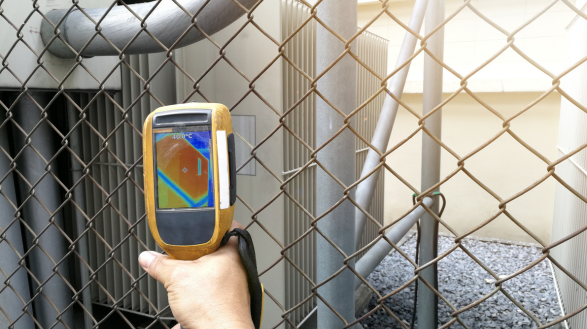Thermographic imaging, or thermal imaging, has become one of the most valuable diagnostic tools available for businesses. By using non-contact infrared technology to capture heat pictures, engineers can identify hot spots within electrical systems.
This powerful technique enables them to predict maintenance requirements, prevent potential faults, and ensure uninterrupted day-to-day operations. In this blog, we explore the numerous benefits of thermographic imaging and its impact on maintaining the integrity of electrical systems.
1. Identifying electrical issues before they escalate
Electrical connections that become loose over time pose a serious risk. Increased resistance to current can lead to a rise in temperature, potentially causing component failures, unplanned outages, injuries, and unnecessary energy consumption.
Thermographic imaging allows engineers to quickly locate these hot spots, assess the severity of the problem, and determine the appropriate timeframe for repairs. By addressing issues proactively, businesses can avoid costly downtime, improve safety, and minimise energy wastage.
2. Non-contact, non-destructive analysis
One of the key advantages of thermographic imaging is its non-contact nature. Engineers can capture heat pictures without physically touching the electrical equipment, eliminating the risk of accidental damage or injury during the inspection process. This non-destructive analysis ensures that operations remain undisturbed, saving both time and resources.
3. Rapid detection of faults
Traditional methods of detecting electrical faults often involve invasive procedures or shutting down systems for inspection. With thermographic imaging, engineers can quickly scan large areas and identify potential issues without disruption. This swift detection not only saves time, but also allows for prompt corrective actions, minimising the impact on business operations.
4. Preventive maintenance and cost savings
Thermographic imaging plays a crucial role in implementing preventive maintenance strategies. By regularly inspecting electrical systems and identifying emerging faults, businesses can schedule maintenance activities at their convenience, reducing the likelihood of unexpected breakdowns.
This proactive approach helps to avoid costly emergency repairs, equipment replacements, and associated downtime. Moreover, preventive maintenance enhances the lifespan of electrical equipment, leading to long-term cost savings.
5. Enhancing safety
Electrical system failures can have severe consequences, including fires, equipment damage, and potential harm to personnel. Thermographic imaging acts as an early warning system by highlighting areas of concern, allowing businesses to take corrective measures before accidents occur. By prioritising safety through regular inspections, businesses can create a secure working environment and demonstrate their commitment to the well-being of their employees.
6. Improved energy efficiency
Inefficient electrical systems can consume excessive energy, leading to inflated utility bills and unnecessary environmental impact. Thermographic imaging helps identify energy loss due to overheating, electrical leakage, or improper insulation. By addressing these issues promptly, businesses can optimise their energy usage, reduce costs, and contribute to sustainability efforts.
7. Regulatory compliance
Various industries have stringent regulations governing electrical safety and preventive maintenance. Compliance with these regulations is critical to avoid penalties, legal liabilities, and reputational damage. Thermographic imaging provides businesses with a comprehensive method to meet compliance requirements, ensuring the integrity and safety of their electrical systems.
Thermographic imaging offers a multitude of benefits for businesses seeking to maintain the reliability and safety of their electrical systems. By utilising this non-contact, non-destructive technique, engineers can identify potential faults, predict maintenance needs, and implement preventive measures to mitigate risks. The ability to proactively address issues not only saves time and resources but also improves operational efficiency, enhances safety and reduces costs. Incorporating thermographic imaging into regular maintenance routines is a wise investment that helps businesses to ensure their electrical infrastructure’s longevity and optimal performance.
At Compliance Group we provide our customers with thermographic imaging diagnosis. As electrical connections become loose, there is resistance to the current that can cause an increase in temperature, which can lead to components failing. This can potentially result in unplanned outages and injuries, as well as additional energy being spent generating heat. Thermographic imaging can quickly locate these, determine the severity of the problem, and help establish the timeframe in which the equipment should be repaired. Contact Scott Reynolds, Sales Director at Compliance Group Electrical at CGEsales@compliancegroup.uk today to discuss our thermographic imaging services.
A nationwide
network of intelligent
compliance services.


